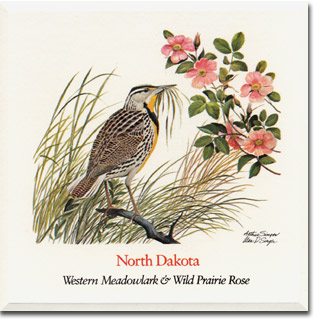The western meadowlark (Sturnella neglecta) holds a special, almost magical, place in the hearts and souls of those inhabiting the prairies of North Dakota. While it is the state bird, the meadowlark is iconic in its stature because it’s one of the first true tests that winter has relinquished its icy grip on the plains. But across the U.S. — North Dakota is no exception — meadowlark numbers are in a state of decline. According to the Cornell Lab of Ornithology, the breeding population of western meadowlarks has been declining throughout the U.S. and Canada at about 1 percent per year since at least 1966.
Sandra Johnson, a non-game biologist with the North Dakota Game and Fish Department, said adding the western meadowlark as a species of conservation priority in its North Dakota Wildlife Action Plan is being considered.
Johnson said factors like pesticide use and habitat changes because of invasive plant species has played a role in the decline, the loss of grasslands is the primary factor behind the drop in numbers.
American robins may get the bulk of attention when it comes to signaling the arrival of spring, but the western meadowlark is likely a better gauge.
Meadowlarks are ground nesters and use natural depressions in the prairie for nests, or shape their own.
They line nests with dried grasses and stems, often using surrounding vegetation to construct a hood or roof, weaving together grass and stems to make a waterproof lid.
Because their melodic, flute-like song is often heard before they are seen, farmers used the return of the meadowlark as a benchmark to indicate soils were warming up enough to plant crops.
According to “The State of the Birds 2013” report, between 2008 and 2011 about 23.7 million acres of grasslands, wetlands and shrublands were converted to crop production.
A recent study by South Dakota State University documented a loss of 1.3 million acres of grasslands in the western cornbelt in the past five years.
From 2006 to 2011, North Dakota lost about 220,000 acres of grasslands that were converted into crop land.
The North American Breeding Bird Survey began in 1966 as a response to the use of the pesticide DDT and effects it had on wildlife populations.
Each year during the peak of the breeding season, June for most of the U.S. and Canada, surveys collect bird population data along roadside routes. Each survey route is 24.5 miles long with stops at ½-mile intervals. There are more than 4,100 survey routes across the continental U.S. and Canada.
In North Dakota there are 48 routes surveyed for western meadowlarks. According to North American Breeding Bird Survey Data, 3,496 western meadowlarks were tallied during the 2007 survey.
In 2012, the number dropped to 2,327. On the group’s website, the western meadowlark is listed as a declining species with significant downward trends nationwide.
Other grassland species on that list include the chestnut-collared longspur, eastern meadowlark, vesper sparrow and horned lark.
Johnson said the state began cataloging species in 2003 as part of a federal directive for its wildlife action plan.
From that plan, about 100 separate animals were identified as species of conservation priority two years later.
Johnson said the action plan and species list are up for renewal each 10 years and by 2015 the western meadowlark and others will likely be added to the list, while others will be removed.
Johnson said several species of bats and freshwater clams could be added to species priority list, along with the American kestrel and the burbot, or ling.
She said multiple agencies are involved with research and there was little discussion when it came to the meadowlark.
“Every agency agreed the meadowlark should be added,” Johnson said. “There were no arguments they should be added as a species of concern.”
The decline in numbers, while statewide, are more pronounced in the eastern part of the state where there is less grass, Johnson said.
There are some funds available to study and possibly work to enhance or conserve habitat through Game and Fish’s State Wildlife Grant program.
Johnson said the Game and Fish Department receives $475,000 a year in federal money for the grant program. She said it was that program that funded a study, and ultimately a trapping season, for fishers in the northeastern part of the state.
Johnson said realistically, there is likely little that can be done to reverse the downward population trend of North Dakota’s state bird.
“The bottom line is we're losing habitat,” she said. “It just comes down to that. It’s a sign of the changing landscape ... less habitat means fewer meadowlarks.”
Source: The Bismarck Tribune, 19 December 2013
http://bismarcktribune.com/lifestyles/outdoors/sign-of-the-times-meadow…

- Login om te reageren
